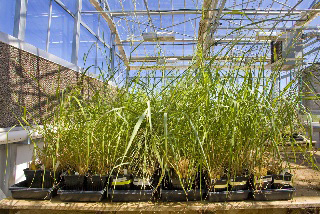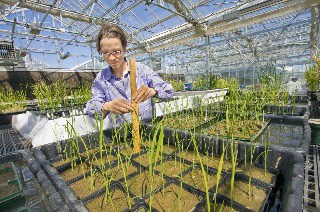Cellulosic biofuels may be viable alternative to gas within 5 years
High fuel prices to make cellulosic biofuels increasingly competitive with gas
Madolyn Rogers, special to mongabay.com
June 2, 2008
|
|
A new institute in the San Francisco Bay Area is seeking to make cellulosic biofuel an economically viable alternative to corn ethanol and gasoline within the next five years.
The Joint BioEnergy Institute (JBEI), a partnership between three national laboratories and three Bay Area universities, was formed in June 2007 after the U.S. Department of Energy awarded the institute a $125 million grant to develop better methods for making liquid biofuels from the natural cellulose in trees and grasses. JBEI researchers expect cellulosic biofuels to yield more energy, produce less greenhouse gases, and have less impact on the environment than other alternatives to gasoline, such as corn ethanol. The primary need for such fuels is in the transportation industry, institute scientists believe.
 Switchgrass in the research lab of Professor Pam Ronald at UC Davis. |
“You can’t fly planes on photovoltaic panels,” said Harvey Blanch, chief science and technical officer at JBEI. “You’ve got to have high energy content liquid fuels. There’s just some applications where there’s no alternative.”
U.S. production of corn ethanol has surged to meet the need for alternative fuels, a trend favored by midwestern politicians but decried by many environmental experts. Cellulosic ethanol would be a major improvement over corn ethanol, said Raya Widenoja, a biofuels expert at the Worldwatch Institute, an environmental group in Washington, D.C.
Corn requires water and fertilizers to grow, which degrades soil and water quality, Widenoja said. Corn produces relatively few tons of usable biomass per acre, and corn ethanol also competes with cultivating crops for food. What’s more, corn ethanol provides only about a 12 percent reduction in greenhouse gas emissions over gasoline, according to a University of Minnesota study.
By contrast, most cellulosic ethanol crops are grasses or scrubby trees, native plants that grow without water or fertilizer. The prairie grass miscanthus grows up to 13 feet tall and can produce 15 tons of biomass per acre, more than three times the yield of corn, according to JBEI scientists.
Growing such crops is better for the land, and far better for the atmosphere, Widenoja said. Burning cellulosic ethanol would produce 80 to 90 percent fewer greenhouse gas emissions than gasoline, according to Widenoja.
 JBEI’s new facility at Emery Station East, Emeryville, California |
That all sounds promising, but there’s a serious problem: producing liquid fuels from cellulose is currently too inefficient to compete with gasoline. In 2007 it would have cost about a dollar more per gallon to run a car on cellulosic ethanol than on gasoline, according to Department of Energy estimates, although with recent gasoline price increases that difference has almost disappeared. JBEI’s five-year mission is to improve the production method significantly.
The consortium is led by Lawrence Berkeley National Laboratory and also includes Lawrence Livermore National Laboratory, Sandia National Laboratories, the Carnegie Institution at Stanford, and the University of California campuses at Davis and Berkeley. JBEI will focus its efforts on two types of plants: woody trees such as poplar, and prairie grasses such as switchgrass and miscanthus.
The institute faces three major technical challenges, Blanch said.
The first is to develop new plants with weaker cellulose. Cellulose is the fibrous component of plant cell walls that makes plants rigid. To make fuel from it, researchers break down cellulose into simple sugars, then ferment those sugars into ethanol — roughly similar to making moonshine. Cellulose is so tough, however, that breaking it down requires great energy, driving up the cost of the process.
“Plant biologists haven’t been awfully well funded over the years, so we really know very little about how plants work,” Blanch said.
 JBEI researchers cultivate rice in the research lab of Professor Pam Ronald at UC Davis. |
To address this, the institute’s scientists initially will study how the plant cell wall is made, so that they may unmake it more easily. The researchers will study two small plants with known genetics, rice and arabidopsis, a type of flowering mustard. Blanch said he believes better fuel plants could be developed within the institute’s five-year time frame.
The second challenge, breaking down the cellulose, “may be the most expensive and sensitive step,” Blanch said. The institute will search for new enzymes, or ways to improve existing enzymes, a goal Blanch also thinks is attainable within five years. Animals that are experts at breaking down cellulose, such as cows and termites, are promising sources for new enzymes.
“Currently it takes anywhere from 30 to 60 hours with enzymes to break down a plant cell wall. If we could do that in five hours, that would be a huge cost savings,” he said.
The final challenge is to ferment plant sugars into better biofuels than ethanol, a goal that may be beyond JBEI’s immediate reach, Blanch said. Ethanol is not the best fuel, according to Blanch, because it’s hard to separate from water, making its production expensive. It’s also corrosive, so it can’t be transported in current U.S. gasoline pipelines.
Ethanol’s great advantage is that the technology to use it as a fuel exists now. Therefore the institute’s first product will likely be ethanol made from cellulose, Blanch said.
Even if the institute is successful in making cellulosic ethanol production economically viable, land use issues could pose problems.
“You definitely shouldn’t grow biofuels on land that used to be forest because it will take you a very long time to regain the carbon losses that you made from deforesting virgin land,” Widenoja said.
Instead she recommends biofuels be grown on drier, marginal lands, such as land in Kansas or southern Iowa.
Others also endorse the environmental benefits of using grasslands for cellulosic biofuel production.
“The first thing we have to do is make sure that the long-term fertility of the soil is preserved,” said Bruce Dale, a chemical engineer at Michigan State University who studies cellulosic ethanol production. “One of the reasons I like perennial grasses as a source of cellulosic ethanol is that’s what they do, just kind of by nature, because they have these deep roots and tend to capture nutrients and build up soil carbon over time.”
Another benefit of producing cellulosic biofuel is that animal feed can be produced as a byproduct, Dale said. This further reduces the land use impact, he said, since much of U.S. cropland is currently used to produce animal feed.
But because of the vast amount of fuel the United States consumes, the availability of land may set a limit on how much biofuel we can produce, even under ideal conditions.
“We shouldn’t expect biofuels to replace all or even a major portion of our current oil use,” Widenoja said. “Energy conservation is really the most important thing we can do.”
Madolyn Rogers is a graduate student in the Science Communication Program at the University of California, Santa Cruz.